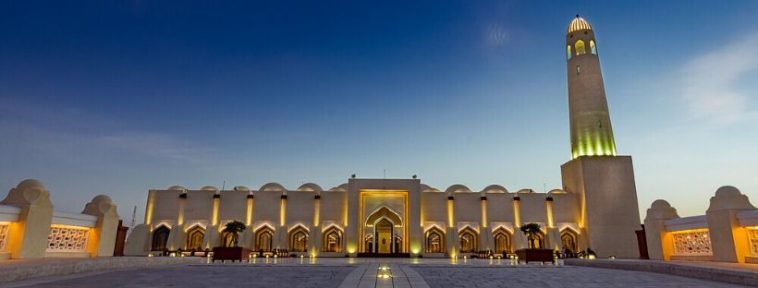The Imam Abdul Wahhab Mosque is undoubtedly one of the most impressive and grandiose mosques in Qatar. Situated in a prominent area of Doha, it is visible from afar and commands a powerful presence. The mosque, also known as the Qatar State Grand Mosque, was opened to the public in 2011 by the then Amir of Qatar, His Highness Sheik Hamad bin Khalifa al Thani. Its contemporary design blends traditional Qatari elements with modern elegance, creating an aesthetically pleasing façade. Inside, the mosque boasts an exquisitely beautiful interior design and layout, making it a must-visit attraction in Qatar.
HISTORY
The history of the Imam Abdul Wahhab Mosque dates back to the late 19th century. The original mosque was built by Sheikh Jassim bin Mohammed Al Thani, the founder of Qatar, in memory of his father.
During the early 20th century, the mosque was expanded and renovated several times. However, by the turn of the 21st century, it had become dilapidated and was in need of major refurbishment.
In 2006, the mosque was closed for a major renovation project that lasted several years. The refurbishment was carried out by a team of Qatari and international architects, engineers, and craftsmen, who worked to restore the mosque to its former glory while incorporating modern features and facilities.
The refurbished mosque was opened to the public in 2011 by His Highness Father Amir, Sheikh Hamad bin Khalifa al Thani. Since then, it has become a symbol of Qatar’s commitment to preserving its cultural heritage while embracing modernity.
Today, the Imam Abdul Wahhab Mosque is not only a place of worship but also a cultural center that serves the local community. It is the largest mosque in Qatar and can accommodate up to 11,000 worshippers at a time. Its beautiful architecture, elegant interior design, and serene surroundings make it a popular tourist attraction in Qatar.
The
Mosque is situated in the Alajabilat area, which is located to the north of Doha’s city center. The mosque is part of a larger complex that includes gardens, open and covered parking lots, and other facilities. Construction of the mosque began in 2006, with an estimated cost of 420 million Riyals. The total area of the project is approximately 175,164 square meters, with a total covered area of 27,644 square meters, making up 15.8% of the total area.
The mosque is able to accommodate around 11,000 worshippers, with the women’s prayer hall able to accommodate approximately 1,200 people. The courtyard is used during Friday prayers and can hold up to 30,000 worshippers. The design of the mosque is a blend of traditional Qatari and contemporary architecture, with a stunningly beautiful interior design and layout that includes intricate calligraphy, intricate chandeliers, and unique geometric patterns. The mosque is a symbol of Qatar’s commitment to preserving its culture and heritage while embracing modernity and progress.
The man behind the mosque’s name
Imam Muhammad Ibn Abd Al Wahhab (1703 – 1792) was a famous religious Muslim leader, reformer, scholar and pioneer during the 18th century who educate peoples to follow the teaching of the Quran and the Sunnah (teaching and ways of Prophet Muhammad). He had a place with the Najd area located in the Central district of Saudi Arabia.
The Façade

The façade of the Grand Mosque is constructed with sandstone and has preserved traditional highlights of Qatar’s rich legacy and its productive history. The mosque isn’t not high and the smaller domes on the building emulate the structure constraints that Qatar faced when it was not a rich country.
At night, the mosque is lit up with strategically placed lighting that adds to all marvel of Qatar’s most prominent mosque.
There are 93 domes on the Grand Mosque; 65 of them make up the outer quadrangle of the mosque, while 28 bigger sized domes protect the main hall.
There are 20 entrances in the mosque, in which three are main doors and 17 are side entrances. These doors facilitate the large quantities of people entering and leaving the mosque during prayer times to avoid congestion.
The size
In addition to the main prayer hall for men and women, the ground floor also includes a dedicated area for performing ablutions (washing before prayer), as well as a space for people with special needs. The mezzanine level, on the other hand, houses the women’s prayer area, a library, and two classrooms. The VIP area is also located on the mezzanine level.
The mosque complex also includes several other facilities, such as gardens, open and covered parking lots, and a conference hall. The car parks occupy more than 2,000 square meters and have a capacity for about 347 cars, with 600 square meters reserved for VIPs.
Overall, the Imam Abdul Wahhab Mosque covers a total area of approximately 175,164 square meters, with a total covered area of 27,644 square meters, accounting for 15.8% of the total area. The mosque can accommodate about 11,000 worshippers, while the courtyard is used during Friday prayers by around 30,000 worshippers.
The interior

The unique architectural design of the Imam Abdul Wahhab Mosque sets it apart from other mosques in the region. The mosque’s 99 domes, consisting of 28 large and 65 small domes, along with six situated in the surrounding landscape, create a stunning visual spectacle. Additionally, a single minaret stands tall as an important architectural feature of the mosque. The main prayer hall for men and women is located on the ground floor and spans an area of 12,000 square meters. The mezzanine level houses the women’s prayer area, library, and two classrooms, occupying a total area of 25,000 square meters.
The mosque’s architecture draws inspiration from traditional Qatari heritage and mimics the form and composition of Boualaqbib mosque located in the market area next to Grand Hamad Street. The site is surrounded by one main street and three secondary streets, with the mosque built in the northwestern part of the site and directed towards Qibla. The design incorporates landscape techniques to accommodate car parks outside the mosque in open areas and links minor roads with the outside main street network. The mosque is accessible through its three main gates, and the prayer hall can be accessed through 17 doors.
The floors of the prayer areas are secured with lush carpets for the easy and comfort for the people to pray and there are lifts for those who need to go up to the mezzanine storey.
3 Storeys
The Grand Mosque has three storeys. There is the cellar, ground floor and mezzanine.
The cellar covers an area of up to 3,853 square meters. It involves bathrooms, a dedicated bathing (wudhu) area for men, and machines.
The ground storey covers an area around 12,117 square meters. It includes the men’s prayer hall and women’s prayer area, a dedicated bathing (wudhu) area for women along with a special area that takes into caters to the needs of women.
The mezzanine floor plan is more modern in design compared to the ground floor. The area is divided into four sections, with the central section containing the women’s prayer hall and two classrooms. The east and west sections each contain a library, and the northern section houses a VIP lounge.
The women’s prayer hall, located in the central section, is accessed through a separate entrance and is designed to accommodate about 1,200 worshippers. It is decorated with Islamic calligraphy and has a beautiful chandelier hanging from the ceiling. The two classrooms, located adjacent to the women’s prayer hall, are used for religious education and other activities.
The library located in the eastern section contains a collection of Islamic books and is open to the public. The western section library contains books on Qatari heritage and history. The VIP lounge, located in the northern section, is reserved for VIPs and dignitaries and has its own separate entrance.
Overall, the mezzanine floor design provides a more private and intimate space for worship and other activities, while also showcasing the beauty of Islamic architecture and design.
The mezzanine floor of the Imam Abdul Wahhab Mosque serves as a connector between the external courtyard and the main prayer hall. The design allows for horizontal and vertical connections, creating a third dimension to the architectural spaces, especially in the main prayer hall on the ground floor. The mezzanine also houses the women’s prayer hall, a library, and two classrooms. The use of traditional woodwork and intricate designs on the walls and ceilings adds to the mosque’s beauty and elegance.
The use of local materials, such as white marble, Qatari limestone, and Islamic geometric motifs in the decoration, contribute to the local character of the mosque. The use of Islamic geometry is particularly prominent in the design of the large dome, which is composed of hexagonal and triangular shapes that form an intricate pattern.
The mosque also incorporates sustainable design features, such as the use of natural light and ventilation, which reduce energy consumption. The roof of the mosque is designed to collect rainwater, which is stored and used for irrigation and other non-potable uses.
In addition to its religious functions, the mosque serves as a cultural and educational center, with a library, lecture halls, and classrooms. The library houses a collection of books on Islamic history, culture, and science, as well as contemporary works on a variety of topics.
The minaret of the Imam Abdul Wahhab Mosque is designed in a modern style that resembles a lighthouse. It has a square base that gradually tapers towards the top, with narrow slits for windows. The minaret’s proportions harmonize with the overall design of the mosque, both vertically and horizontally. The facades of the mosque are also kept simple, with two vertical parts; the lower part at the height of the gates, and the upper part with small, narrow openings and windows to keep the temperature inside low.
Parking place
The parking place covers an area around 14,877 square meters, so there is more than ample parking for the people who come to pray at the mosque or visit it. And there are 9 different parking places, including an indoor one, that can accommodate 300 vehicles.
Mosque guidelines
All guests to the mosque, including those that are coming to prayers are mentioned to follow the guidelines give below:
- Don’t make noise; put mobiles on silent mode while in the mosque.
- Honor the mosque’s sacredness and avoid improper conduct.
- Honor the holiness of the mosque by sitting in a restrained way
- Honor and regard others guests and prayer performers.
- Honor the sacredness of the mosque and prayer performers while taking photos, i.e., not lying down or using some other improper development or posture.
- Footwear must be kept in the shoe racks given outside the prayer halls.
- Food and beverages are not allowed inside the mosque; to drink water is available inside the mosque.
- It is your duty to deal with your personal belongings.
- An earlier written authorisation is required from the Mosque office in case of taking photos or making video recording for business or private purposes.
- To keep the peace and quiet in the mosque, kids under seven years old are not permitted to enter the prayer halls during Ramadan between the Isha prayer and the Qiyam (12 PM prayer) and during lecture times.
- Childrens under seven years old are just allowed to enter the women’s prayer hall on the ground floor.
- It is illegal to take photos in the women’s prayer halls.
Mosque etiquettes if you are a non-Muslim
If you are a not a Muslim then i wish to visit this Grand Mosque, entry is free but there are some mosque ways and guidelines that you must follow.
- Passage might be confined at specific times, so please get some information about visiting times.
- When you are visiting the mosque, it would be helpful if you wear clothes that cover the entire body. Women must wear an abaya and headscarf that can be given to them by a female watchman at the entrance.
- Honor the sacredness of the mosque and avoid inappropriate conduct while there.
- Don’t not visit the mosque at prayer times.
- Remove your shoes and place them on the shoe racks available.
- Try not to disturb the worshippers.
- Keep your mobile switched off when you are in the mosque premises, so don’t disturb the tranquility of the mosque.
- Tourist groups, special visits and visits for finding Islam, are to be arranged by required procedures two days before the visit and in case of cancellation, the mosque should be informed accordingly.
- Food from outside is not allowed in the mosque; to drink water is available inside the mosque..
- Take permission from the mosque office if you need to use your camera to take photos.
Area
The Grand Mosque is located in the Jubailat area in Doha on Al Mohandeseen Street. It isn’t too far from the Corniche and has been built on a large hill, so it can be seen from a far distance. It overlooks the Qatar Sports Club and the magnificent Doha skyline of West Bay.
Details
- Location: Al Mohandiseen Street, Jubailat area
- (close by to the Doha Corniche and West Bay area)
- Contact: +974 4425 0250
Please Subscribe Us to get updated with Qatar News, Saudi News, Kuwait News, Health News, UAE News, Iqama, Visa, Jobs, Banking and More.



